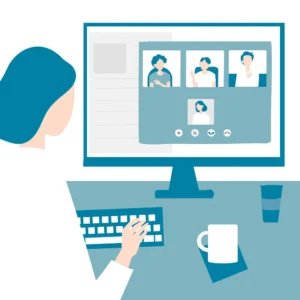This is the latest entry in a series of blogs based off the latest Level Five Associates book, The Power of Being All In.
Can We Hear Each Other?
One of the most transformative elements of our lives now that the world has changed is what our workplace looks like. For many of us, the hybrid office is the new normal.
It is an interesting paradox… when you look back only a few years to the height of the pandemic, workers were told they could not physically come to work. So, people worked from home or didn’t work at all. Many others, though, had to come to work. Their physical presence was deemed “essential.” Thus, we ultimately ended up with a mixed bag of workforce configurations, which none of us were prepared for.
Consider these fundamental changes the mixed (or hybrid) office has created:
- Employees have fewer in-person interactions. Even with the lifting of most stay-at-home policies, many workers still only go into the office one or two days a week.
- Employees spend less time in employer-controlled spaces. On average, they spend 65% less time in their offices today than before the pandemic.
- Employee ecosystems are shrinking. Employees who have “weak ties” with other workers are now in the office less, so those ties are even more episodic.
- Employee teams are less stable. The “bias for proximity” has stratified teams and decreased their effectiveness.
This workplace transformation has created an enormous number of second- and third-order effects. Not the least of which is the significant erosion of our communication skills. Can we still hear each other? Do we remember how to listen?
Our increasing dependence on electronic information exchange has deluded us into thinking the transfer of information equals communication. Nothing could be further from the truth. We have deceived ourselves into believing this myth. 
I remember any number of meetings I attended as a young Army officer where the session wrapped up with the boss asking, “OK, got it?” And universally, the answer was silence or positive head nods. Then, we proceeded to go out and do something different because we had not really heard and understood what our superior had instructed us to do.
Now, this tendency to nod heads is magnified in the hybrid workplace with the increasing use of email and texts to convey information among people who are physically dispersed. It’s the perfect storm. We don’t confirm what we read or heard (a term I call the backbrief).
Virtual workers now feel disconnected (or, to paraphrase the words of the outstanding play Hamilton, they are not in “the room where it happened”). The hybrid office requires us as adaptive leaders to be increasingly empathetic – Put ourselves in the shoes of our most remote workers, and act accordingly. Enjoy the journey!
 This blog post is based on the book, “The Power of Being All In.” You can download the first chapter for free at this link. Or, if you’d like to purchase the entire book (available in paperback, eBook, and audiobook), it is available on Amazon.
This blog post is based on the book, “The Power of Being All In.” You can download the first chapter for free at this link. Or, if you’d like to purchase the entire book (available in paperback, eBook, and audiobook), it is available on Amazon.
Did you find this blog post beneficial? If so, please consider sharing it with your audience. It’ll just take a second, but could improve someone’s work habits for a long time to come.





